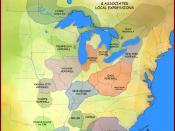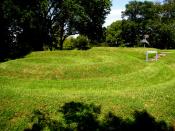The most famous of all effigy mounds is the Great Serpent Mound in Adams County, Ohio. It is 1, 330 feet in length along its coils and averaging three feet in height.
Serpent Mound, an embankment or earth resembling a snake nearly a quarter-mile long, is the largest and finest serpent effigy in North America. Who built the mound - one of the few effigies in Ohio - and why they constructed it remains a mystery.
The mound represents a gigantic snake uncoiling in seven deep curves along a bluff overlooking Ohio Brush Creek; the oval embankment near the end of the bluff probably represents the open mouth of the serpent as it strikes.
Serpents are prominent in the religious beliefs of many peoples as symbols of evil forces or benevolent deities. To some ancient societies, they represented eternity because their habit of shedding their skin seemed to be a renewal of life.
In eastern North America, snakes figured in American Indian mythology and religious beliefs. Traditionally, some Native Americans used snake teeth or flesh in rituals to cure illness, and wore rattlesnakes to assume the power of the reptile and frighten their opponents in games. They also tattooed their bodies with serpent images and engraved them on their ornaments.
The serpent undoubtedly symbolized a significant religious or mystical principle for the builders of Serpent Mound because of the time and effort that must have been spent constructing it. However, the details of that belief are unknown. The builders carefully planned the effigy, first outlining its form with stones and clay mixed with ashes and then covering it with basket loads of earth.
Serpent Mound was not built over any burials or remnants of living areas, nor was there any artifacts found in it to identify which prehistoric culture constructed...


